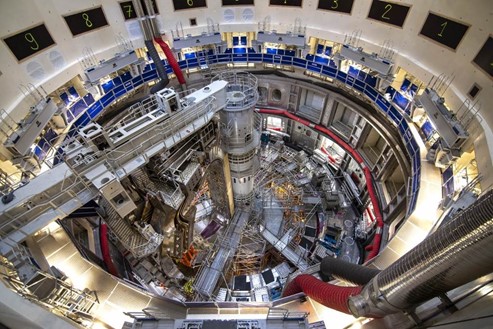
Nuclear fission and nuclear fusion: what you should know
Fission and fusion, what are the differences?
The phenomena of nuclear fusion and nuclear fission have one unique point in common: the atom.
The process of fission, as its name suggests, consists of the division of a heavy atom into 2 light atoms. With fusion, the phenomenon is reversed: two light atoms combine to form a larger atom.
The phenomenon of nuclear fission
Fission occurs when a neutron strikes a heavy and unstable atom. This collision causes the atom to split into 2 lighter atoms.
In the process, a large and stable quantity of energy and new fissions of atoms continue to be triggered on an ongoing basis, which is known as a chain reaction.
In this operation, the fuel used is uranium 235. Its composition and physical properties are perfectly suited to the fission process. The atomic nucleus of uranium 235 is capable of splitting in 2 under the impact of a neutron.

Experimentation with nuclear fusion:
In contrast to nuclear fission, energy from fusion is still at the experimental stage. It is more difficult to put into practice because of the need to meet extreme conditions of pressure and temperature.
The process is equivalent to the nuclear reaction which takes place at the core of stars, like our Sun (thus requiring a temperature of hundreds of millions of degrees).
“Did you know?
The Sun is a ball of hot gas which radiates and produces energy. At the core of the Sun, temperatures can reach up to 15 million degrees.
Nuclear fusion reproduces the combination of 2 isotopes (type of atoms with an identical number of protons) of hydrogen: deuterium and tritium.
The fusion of these stable and light isotopes of hydrogen gives rise to a helium atom. It is this reaction which releases a large quantity of energy.
One of the major benefits of deuterium is that it is available in unlimited quantities in the Earth's oceans. Combined with tritium (which is not very unstable), this radioactive mixture can generate a quantity of energy sufficient to meet the growing demand of global populations.

Nuclear fission, proven track record in industrial operation

In France, reactors use the process of nuclear fission. They are pressurized water reactors.
Originally, nuclear fission was discovered by an Austrian physicist, Lise Meitner and the German chemist, Otto Hahn, who received the Nobel Prize for Chemistry in 1944 for his discoveries.
It was not until the 1960s that fission technology came to be used in the generation of electricity, with the design of the first civil reactors.
The technology has evolved considerably since. Originally, the reactors contained natural uranium and required heavy water laden with graphite to slow down the neutrons. Heat transfer was achieved by using gas and thus generated CO2 emissions.
Today, nuclear technology in France uses pressurized water reactors, containing hydrogen, and no longer make use of gas. Water is used as a neutron moderator and coolant.
The uranium used as fuel is now enriched to contain more uranium 235, rather than using natural uranium.

The technology of nuclear fission is mature and has a proven track record. It helps to meet people's electricity needs while producing low-carbon energy.
For further information: Why turn to nuclear power to combat global warming? | Orano
Throughout the world, nuclear fission is being used for other applications in different reactor designs, such as 4th-generation fast neutron reactors.
Fusion energy and the reactors of the future

Still at the experimental stage, nuclear fusion gives us hope of being able to produce low-carbon energy in large quantities and on an almost continuous basis. It would generate very little waste, which would also be considerably less radioactive.
For the same quantity of material, nuclear fusion would make it possible to produce 4 million times more energy than fossil fuels: oil, gas and coal.
Representing a real technological challenge, this process requires the confinement of heat at a temperature of 150 million degrees. The reactors have to prevent the walls from melting while maintaining fusion for as long as possible.
Two methods are used to achieve the fusion of atoms: inertial confinement and magnetic confinement.
Inertial confinement
With inertial confinement, the nuclear fusion is triggered by focusing high-power laser beams onto a fuel capsule, which contains a mixture of deuterium and tritium.
Heated to very high temperatures, these two isotopes of hydrogen atoms then collide and fuse into heavier helium atoms, producing a colossal volume of energy.
Today, there are only two places in the world where experiments are being conducted with this type of fusion, one of which is based in France: the Megajoule Laser (Laser Mégajoule – LMJ) near Bordeaux.

Magnetic confinement:
The method of magnetic confinement transforms the deuterium and tritium atoms into plasma, causing them to fuse under the effect of a magnetic field. Experimental reactors are able to reproduce this type of nuclear fusion. These are tokamaks, whose ring-shaped core enables the hydrogen gas to be transformed into plasma, under the influence of extreme temperature and pressure.
The magnetic coils around the wall are used to control the plasma particles.
One of the flagship projects in fusion energy is ITER, also located in France. The tokamak has to be capable of containing a temperature of 150 million degrees. The objective of this project is to open the way for the harnessing, production and industrial commercialization of hydrogen fusion.

In China, the EAST tokamak nuclear fusion reactor broke a record in January 2022, by maintaining a temperature of 70 million degrees (equivalent to four times the temperature at the core of the Sun) for over 17 minutes.
The Chinese reactor was also successful in containing 120 million degrees for 101 seconds and 160 million degrees for 20 seconds.
Even if nuclear fusion reactors are promising and have key role to play in our energy future, they are not expected to be in industrial operation before 2050.
Find out more about fusion in this explainer video:
- A kilogram of deuterium and tritium mixture can provide as much energy as around 4kg of uranium 235 and as much as around 10,000 metric tons of coal.

- All about nuclear energy Nuclear energy is a relatively recent invention that has continued to evolve since the last century. This powerful, low-carbon energy is continuously available to satisfy our various energy needs.
- All about uranium Uranium is a metal ore that occurs naturally in the earth’s crust. Find out where it comes from, the difference between uranium 235 and 238, its uses in fuel, etc.
- Isotopes: what to remember